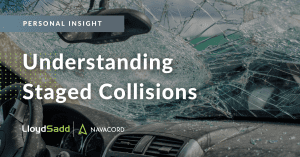Understanding Staged Collisions

Spurious road traffic accidents—where criminals aim to profit from fraudulent insurance claims—are not new events. These intentional, staged scams can include fabricated personal injury claims following minor accidents and staged collisions. Notably, auto insurance fraud, such as these types of scams, costs Ontario drivers an estimated $1.6 billion each year according to Finance Minister Charles Sousa.
Therefore, it’s crucial for you to understand staged collisions and know how to avoid and respond to them.
Types of Staged Collisions
The Insurance Bureau of Canada explains that auto fraud includes false injury claims, exaggerated claims through body shops and medical clinics, and staged collisions. The latter usually fall into three main categories:
- The swoop and squat—One vehicle swoops in front of the victim while an accomplice follows closely behind, crashing into the victim when they brake.
- The drive down—Usually taking place in parking lots, a scammer waves at the victim to back out of their parking space before intentionally crashing into their vehicle.
- The bullet left turn—While a vehicle is indicating to turn left, a fraudster waves the driver across before intentionally driving into their vehicle as they turn.
Unfortunately, commercial drivers could be an attractive target for staged collisions due to their likelihood of having more comprehensive coverage types through their employers, which fraudsters could prey on. As such, it’s critical that anyone who drives a vehicle for work purposes knows how to avoid staged collisions and what to do in the event of such scams.
Tips to Avoid Staged Collisions
Staged scenarios can’t always be predicted, but there are ways you can help protect yourself while on the road. Consider the following tips to help avoid staged collisions:
- Look ahead while driving to spot any potential hazards, such as unusual driving behaviour. For instance, drivers paying attention to vehicles behind without due reason or vehicles travelling unusually slowly or erratically could indicate a potential scam.
- Maintain a safe braking distance from the vehicle in front of you. The gap will vary depending on the speed you’re travelling; typical stopping distances are 12 metres when driving at 32 km/hr and 96 metres at speeds of 113 km/hr.
- Be aware of your surroundings and adjust your driving habits as needed. Specifically, drive defensively, always stick to the Highway Safety Code and never assume that someone waving you through means it’s safe to proceed.
- Remain cautious when pulling out of a side road, especially if encouraged to.
Responding to a Staged Collision
While you can take these preventive measures to avoid staged incidents, they can still happen. Therefore, it’s important to know how to respond.
If you believe you have been in a targeted staged collision, take the following steps:
- Do not confront the driver about the crash, admit liability or challenge the driver about any suspicions.
- Exchange details as legally required.
- Take detailed notes about the driver, any passengers and the circumstances of the crash.
- Take photographs as discreetly as possible of the scene and the damage to both vehicles.
- Report the incident, along with your suspicions, to the insurer as soon as possible.
- If you suspect you have been a victim of a staged collision, call the Insurance Bureau of Canada’s confidential tip line at 1-877-IBC-TIPS.
If you believe you’ve been a victim of a staged collision, it’s important to protect all parties involved and avoid escalating the situation.
Speak to your supervisor for more vehicle-related safety guidance.
To download the insight, click here: [Personal Lines]_Understanding Staged Collisions_Lloyd Sadd